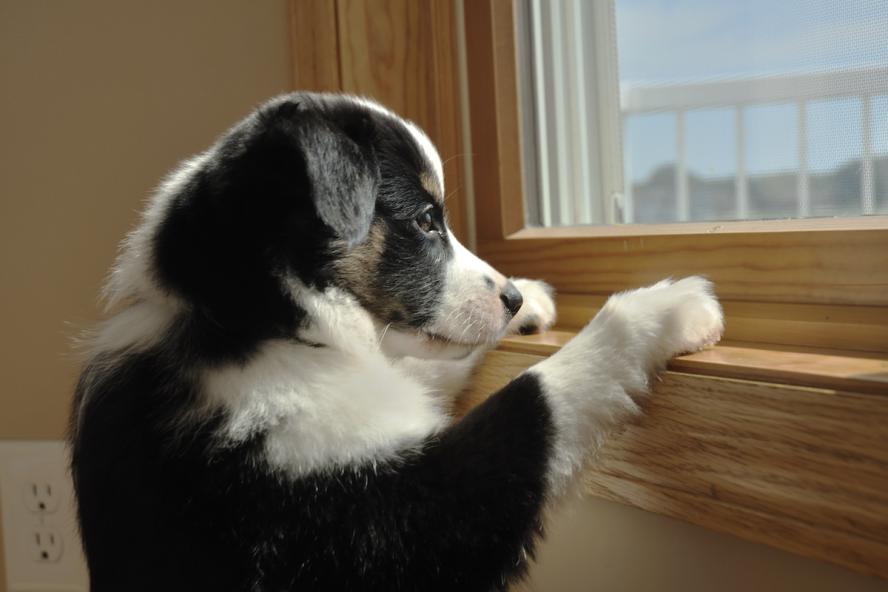-
About
- Leadership & Faculty
- News & Events
-
Academics
- Graduate
- Advanced Clinical Training
- Continuing Education
- Academic Departments
- Academic Offices
- Simulation Experiences
-
Student Life
- Offices
-
Research
-
Hospitals & Clinics
- Emergency Care
- Hospital Services
-
Community Outreach
- Volunteer
Anxiety in Dogs
Things to Know

With our busy lives, including flexible work schedules, we need to be aware of how our dogs are responding. Here are some things to consider if you think your dog may have anxiety.
Warning Signs
Dogs are very expressive, so there is much to learn by observing their body language and behavior. An anxious dog may pant, pace, tremble, drool, withdraw from its owner, or hide. Alternatively, they may appear irritable or aggressive (i.e., bark or growl at someone). The dog’s tail may be low or tucked, ears back, eyes dilated or showing lots of white around them (whale eye). Their body carriage may be low and their manner hesitant or avoidant.
Anxious dogs may also appear extra friendly and continually approach, jump on someone, and lick their face, or just be needier with the owner. They may demonstrate displacement behaviors, which are normal behaviors that occur out of context when a dog is stressed. Common displacement behaviors are yawning when not turned, stretching when not stiff, rapid blinking when nothing is in the eye, sneezing when there is nothing bothering the nose, and sniffing the ground or scanning the environment when there is nothing of interest or when nothing has happened.
Dogs that are anxious may also urinate inside. This is common in dogs with separation anxiety. Urination in the house in this case (as well as defecation) is a sign of anxiety, not resentment or anger, which is a common misconception among dog owners.
Dogs that are anxious all the time (as opposed in the presence of something that makes them uneasy) may become depressed or irritable, sleep more, and may lose interest in food, training, play, and social interaction. Chronic anxiety may also lower a dog’s threshold for allergies, inflammatory bowel diseases and other medical problems.
Keys to Prevention as a Puppy
The best way to prevent anxiety is to ensure dogs get appropriate socialization and exposure (in a non-stressful way) to a variety of novel situations during the developmental stage (3–14 weeks old). Two helpful books on this topic are Puppies First Steps by Kenneth and Debbie Martin, and Perfect Puppy in 7 days by Dr. Sophia Yin.
Puppy owners need to continue providing socialization opportunities for the next several months, when the dog consolidates its learning.
Prevention Tips as an Adult
To prevent anxiety and chronic stress when a dog is an adult, note the following:
- Consistency and predictability in a dog’s routine
- Plenty of exercise and mental stimulation (appropriate to the dog’s age, breed, interests, health)
- Good understanding of and respect for a dog's body language and social signaling. Recommended read: Doggie Language: A Dog Lover’s Guide to Understanding your Best Friend by Lili Chin
- Positive reinforcement/negative punishment (force free) training. Training opens communication between a person and a dog. It is not just about getting skills.
- Respect for a dog’s needs to be petted or not, to rest, to eat in peace, to spend time alone and time with people.
- Regular medical care
There is a lot of unscientific and dangerous advice about dog behavior that contributes to anxiety in our canine companions. For example, dogs want good predictable communication, not domination or force from their owners. Dogs do not live in packs as wolves do but make loose social affiliations, which is why they can go to a dog park and wolves could not.
There are some dogs that have unmanageable anxiety despite the excellent environment. These dogs may need help from a veterinary behaviorist.
Calming an Anxious Dog
Calming a dog exhibiting anxiety depends on the situation. If a dog has separation anxiety for example, they will need to do a program of behavior modification and may need some anti anxiety medication.
If a dog is frightened of storms, for example, create a safe space for the dog (e.g., in the basement with white noise, calming music, etc.) and consult with their veterinarian about situational medication for storms. Working on relaxation behavior modification exercises may also help. Almost all anxious dogs benefit from positive reinforcement training and increased predictability and consistency in their routine and in interactions.
Dogs with Chronic Anxiety
Dogs exhibiting frequent anxious behavior should see their veterinarian as soon as possible. Pain, itching, illness, discomfort can all lower a dog’s threshold for anxiety and should be ruled out. If there are no medical problems that can be identified, the veterinarian may offer anti anxiety medications, and/or a referral to a veterinary behaviorist.
Also, it does not make an anxious dog worse to comfort him. It does not teach a dog to be fearful by rewarding them when fearful because fear is a feeling and not a behavior and thus not amenable to operant conditioning. Comforting is not likely to be adequate because you may not always be there to comfort the dog, so they need another strategy for managing their fears, such as going to a safe space in a storm. Providing comfort will reinforce the dog’s tendency to see the comforting owner to help manage their fears.
Stephanie Borns-Weil, V07 (she/her), is a board-certified animal behaviorist and oversees the Behavior Service at Cummings School of Veterinary Medicine, where she is a clinical assistant professor in the Department of Clinical Sciences.
Department:
Dept. of Small Animal Clinical Sciences